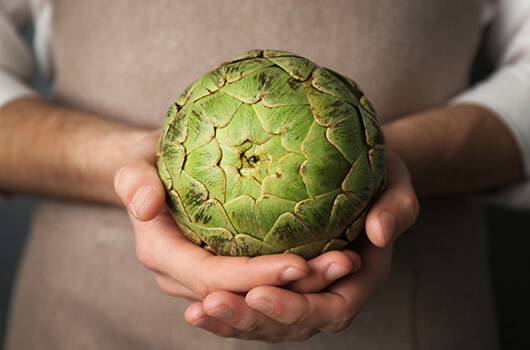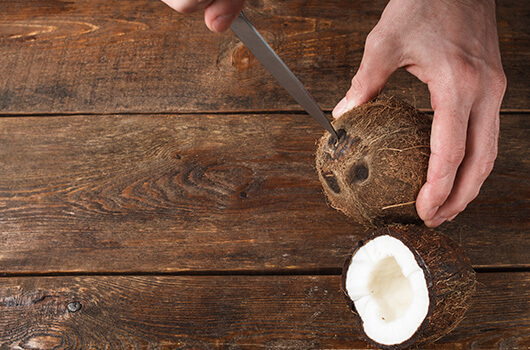
We have to respect a fruit that can draw blood just by grazing your flesh. But once tamed, the pineapple delivers a bounty of health benefits: antioxidant vitamins A and C, copper, manganese and bromelain, which is thought to ease inflammation. Plus, buying a whole pineapple versus pre-sliced or frozen chunks can save you some cash. And it sure tastes a lot more flavorful and juicier.
But, you might be asking yourself, how the heck do I even approach a pineapple without losing an appendage? Armed with a little know-how, victory can be yours but first, the preliminaries:
- Wash your hands with soap and warm water for at least 20 seconds before you start handling food.
- Remove any damaged or bruised areas. If you suspect it could be rotten, toss it out.
- Thoroughly wash the food under running water. It’s okay to scrub firmer produce with a brush.
So don’t be intimidated. Grab a sharp knife and claim your birthright:
Pineapple
What to Look For
A ripe pineapple is mostly firm but will give ever-so-slightly when you squeeze it. The color should be a consistent golden yellow (but a little green is OK), and the base should smell sweet and bright.
How to Prepare
Chop off the top and base. Next, prop that puppy up lengthwise and use a serrated knife to carefully saw off the spiky skin, top to bottom. Then you can cut it into chunks or slice it into rounds as desired.
Artichoke

One of earth’s natural diuretics, the artichoke has a reputation for fighting bloat. But this vegetable has more than one trick up its thorny sleeve. Rich in fiber and folate, it also has tons of vitamins C and K, copper, magnesium, manganese and potassium. Sure, you could buy a can of artichoke hearts but why deny yourself the pleasure of eating the leaves — or the satisfaction of conquest?
What to Look For
The leaves should be tightly packed, not loose or splayed. They also should squeak when rubbed together.
How to Prepare
If you plan to eat the whole artichoke (leaves and heart) start by using a serrated knife to cut off the tips and stem. Then use kitchen shears to snip off any sharp points on the leaves. Once you’ve boiled or braised it, be sure to scoop out the inedible “choke,” a thistle-like substance, using a spoon.
Ginger Root

Good God. Look at that thing. So gnarled. So rooty. How could something so delicious look so filthy? And yet, there it is. Still, we urge you to look past this plant’s dusty veneer and consider its benefits. Long used to calm nausea and indigestion plus, it tastes and smells divine.
What to Look For
Pick up the hand — yes, that’s what it’s called and we think it’s creepy, too — and examine its texture. Choose a section with smooth, taut skin, which should be thin enough to nick with your fingernail. You should also be able to detect its spicy scent.
How to Prepare
Break off as much of the hand (shudder) as you need. Pro tip: If it doesn’t snap easily, it’s probably not fresh. Use a knife to pare off any dry ends and nubs, and then hack away at the larger swaths of skin with a vegetable peeler. If any stubborn bits remain, scrape ‘em off with a spoon. You’re left with lovely flesh for grating, pickling or candying.
Coconut

You may take one look at that hairy stack in the produce section and feel a strong urge to abort mission. Resist! Nutrient-rich coconuts aren’t hard to master, and buying them whole is more cost-effective.
What to Look For
First, check for heft; a good coconut should feel heavy for its size. Next, give that bad boy a good shake. Does it sound like at least a cup of water is sloshing around in there? Great. Now examine the cluster of indentations called “eyes” for cracks, mold or wetness.
How to Prepare
Guys, you get to use a hammer for this! And a screwdriver, which you’ll use to poke a hole in the coconut’s softest eye. Once you’ve pierced the eye, drain the liquid inside by either slurping it up with a straw or pouring it into a glass. Gently hammer a spot toward the center of the fruit until a fracture forms along the circumference. Pull the halves apart and pry the flesh from the shell with a butter knife.
Then, imagine yourself on a desert island and enjoy the sweet bounty.